HONDA PRELUDE 2000 Owner's Manual (in English)
Manufacturer: HONDA, Model Year: 2000, Model line: PRELUDE, Model: HONDA PRELUDE 2000Pages: 293, PDF Size: 3.43 MB
Page 191 of 293
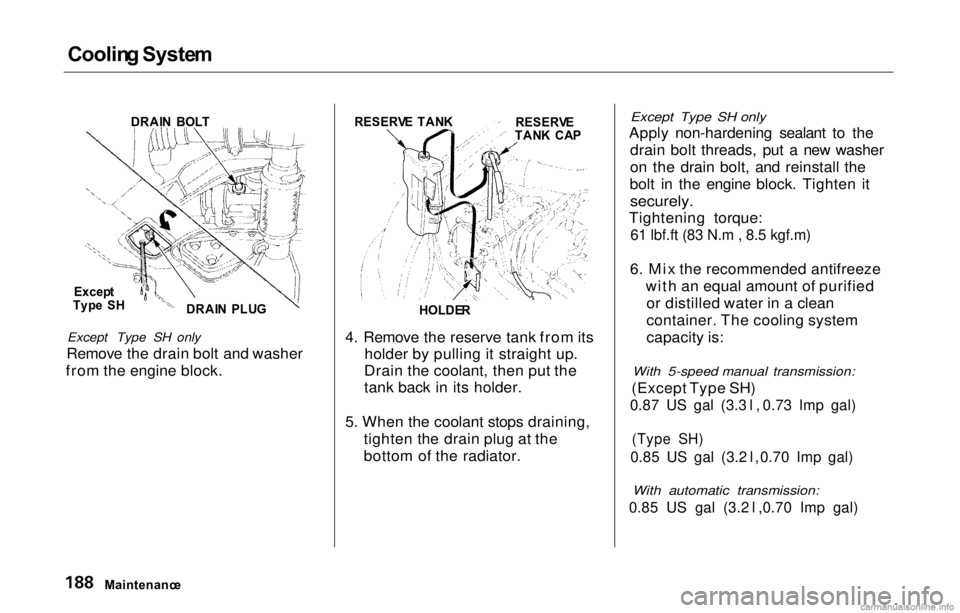
Coolin
g Syste m
Except Type SH only
Remove the drain bolt and washer
from the engine block. 4. Remove the reserve tank from its
holder by pulling it straight up.
Drain the coolant, then put the
tank back in its holder.
5. When the coolant stops draining, tighten the drain plug at the
bottom of the radiator.
Except Type SH only
Apply non-hardening sealant to the
drain bolt threads, put a new washer
on the drain bolt, and reinstall the
bolt in the engine block. Tighten it
securely.
Tightening torque:
61 lbf.ft (83 N.m , 8.5 kgf.m)
6. Mix the recommended antifreez
e
with an equal amount of purified or distilled water in a clean
container. The cooling system
capacity is:
With 5-speed manual transmission:
(Except Type SH)
0.87 US gal (3.3 l , 0.73 Imp gal)
(Type SH)
0.85 US gal (3.2 l , 0.70 Imp gal)
With automatic transmission:
0.85 US gal (3.2 l ,0.70 Imp gal)
Maintenanc e
DRAI
N BOL T
Excep t
Typ e S H
DRAIN PLU G
HOLDER
RESERV
E TAN K
RESERVE
TAN K CA P
Page 192 of 293
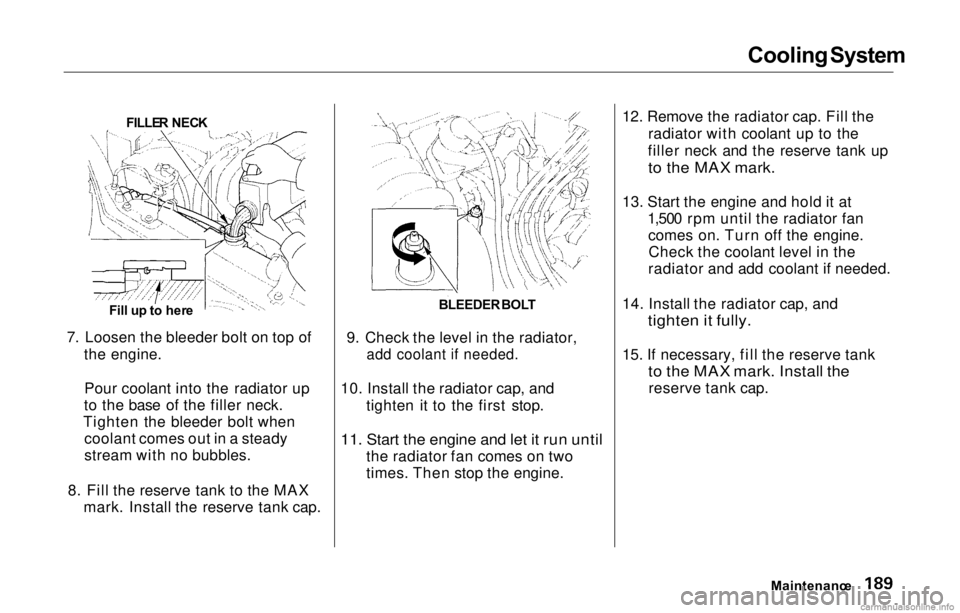
Cooling
System
7. Loosen the bleeder bolt on top of the engine.
Pour coolant into the radiator up
to the base of the filler neck.
Tighten the bleeder bolt when coolant comes out in a steady
stream with no bubbles.
8. Fill the reserve tank to the MAX mark. Install the reserve tank cap. 9. Check the level in the radiator,
add coolant if needed.
10. Install the radiator cap, and tighten it to the first stop.
11. Start the engine and let it run until
the radiator fan comes on two
times. Then stop the engine. 12. Remove the radiator cap. Fill the
radiator with coolant up to the
filler neck and the reserve tank up
to the MAX mark.
13. Start the engine and hold it at 1,500 rpm until the radiator fancomes on. Turn off the engine.Check the coolant level in the
radiator and add coolant if needed.
14. Install the radiator cap, and
tighten it fully.
15. If necessary, fill the reserve tank
to the MAX mark. Install the
reserve tank cap.
Maintenance
FILLE
R NEC K
Fill u p to her e BLEEDER
BOL T
Page 193 of 293
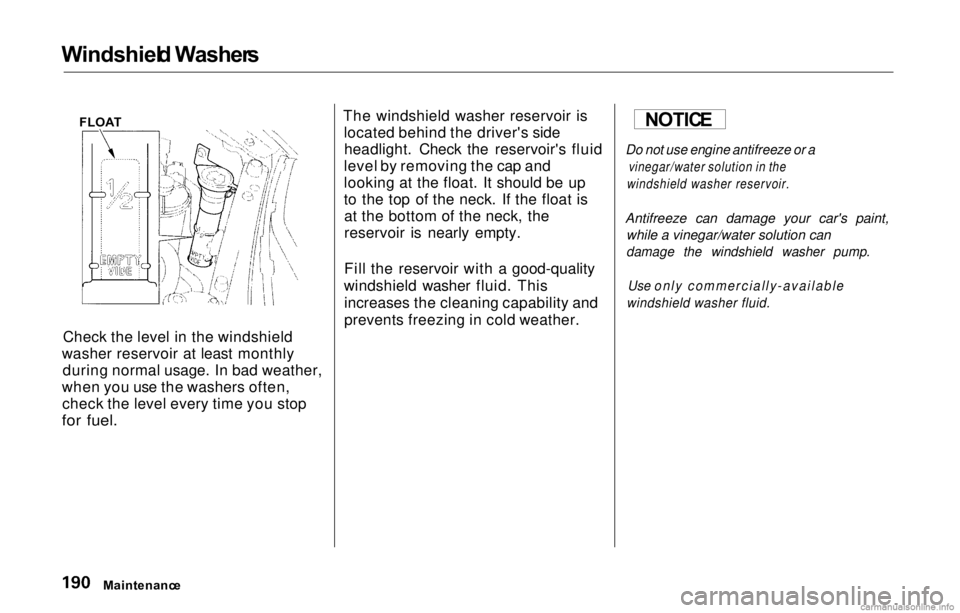
Windshiel
d Washer s
Check the level in the windshield
washer reservoir at least monthly during normal usage. In bad weather,
when you use the washers often, check the level every time you stop
for fuel.
The windshield washer reservoir is
located behind the driver's sideheadlight. Check the reservoir's fluid
level by removing the cap and
looking at the float. It should be up
to the top of the neck. If the float is at the bottom of the neck, the
reservoir is nearly empty.
Fill the reservoir with a good-quality
windshield washer fluid. This increases the cleaning capability and
prevents freezing in cold weather.
Maintenanc e
Do not use engine antifreeze or a
vinegar/water solution in the
windshield washer reservoir.
Antifreeze can damage your car's paint, while a vinegar/water solution can
damage the windshield washer pump.
Use
only commercially-available
windshield washer fluid.
FLOA
T NOTIC
E
Page 194 of 293
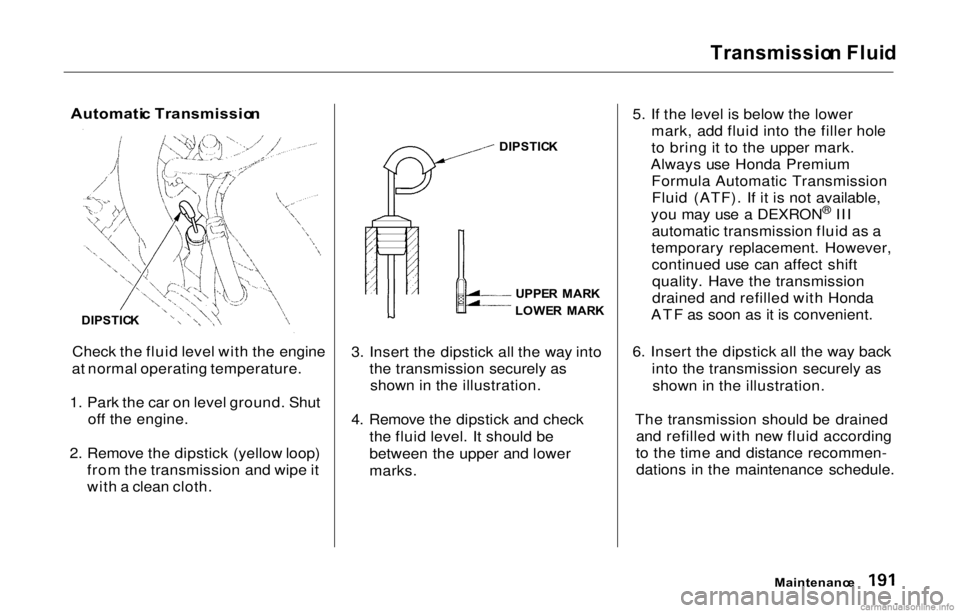
Transmissio
n Flui d
Automati c Transmissio n
Check the fluid level with the engine
at normal operating temperature.
1. Park the car on level ground. Shut off the engine.
2. Remove the dipstick (yellow loop) from the transmission and wipe it
with a clean cloth. 3. Insert the dipstick all the way into
the transmission securely asshown in the illustration.
4. Remove the dipstick and check the fluid level. It should be
between the upper and lower
marks. 5. If the level is below the lower
mark, add fluid into the filler hole
to bring it to the upper mark.
Always use Honda Premium Formula Automatic TransmissionFluid (ATF). If it is not available,
you may use a DEXRON ®
III
automatic transmission fluid as a
temporary replacement. However, continued use can affect shiftquality. Have the transmission
drained and refilled with Honda
ATF as soon as it is convenient.
6. Insert the dipstick all the way back into the transmission securely asshown in the illustration.
The transmission should be drained and refilled with new fluid according
to the time and distance recommen- dations in the maintenance schedule.
Maintenance
DIPSTIC
K
UPPE
R MAR K
LOWE R MAR K
DIPSTIC
K
Page 195 of 293
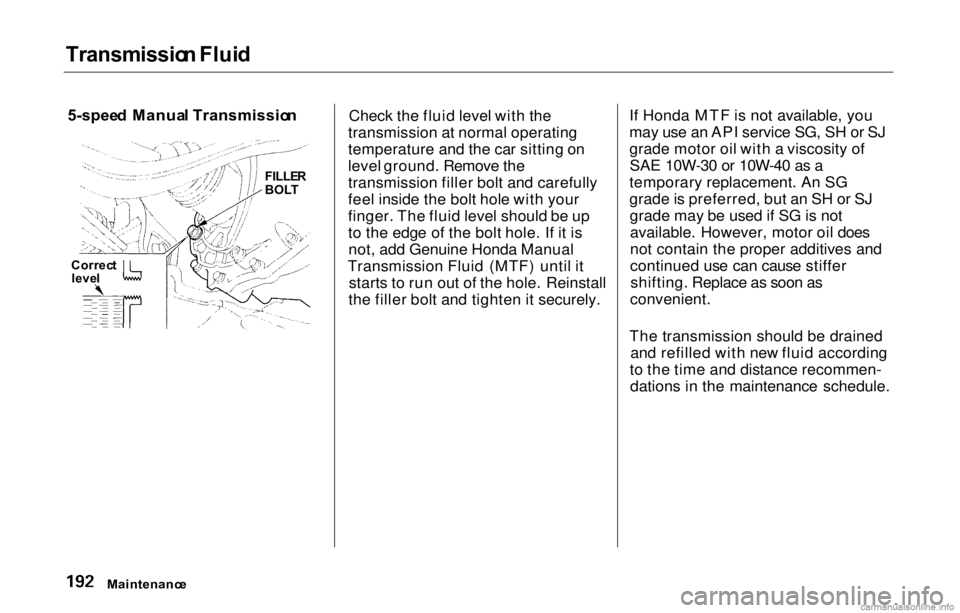
Transmissio
n Flui d
5-spee d Manua l Transmissio n
Check the fluid level with the
transmission at normal operating
temperature and the car sitting on
level ground. Remove the
transmission filler bolt and carefully
feel inside the bolt hole with your
finger. The fluid level should be up
to the edge of the bolt hole. If it is not, add Genuine Honda Manual
Transmission Fluid (MTF) until it starts to run out of the hole. Reinstall
the filler bolt and tighten it securely. If Honda MTF is not available, you
may use an API service SG, SH or SJ
grade motor oil with a viscosity of
SAE 10W-30 or 10W-40 as a
temporary replacement. An SG
grade is preferred, but an SH or SJ grade may be used if SG is notavailable. However, motor oil does
not contain the proper additives and
continued use can cause stiffershifting. Replace as soon as
convenient.
The transmission should be drained and refilled with new fluid according
to the time and distance recommen- dations in the maintenance schedule.
Maintenanc e
FILLE
R
BOL T
Correc t
leve l
Page 196 of 293
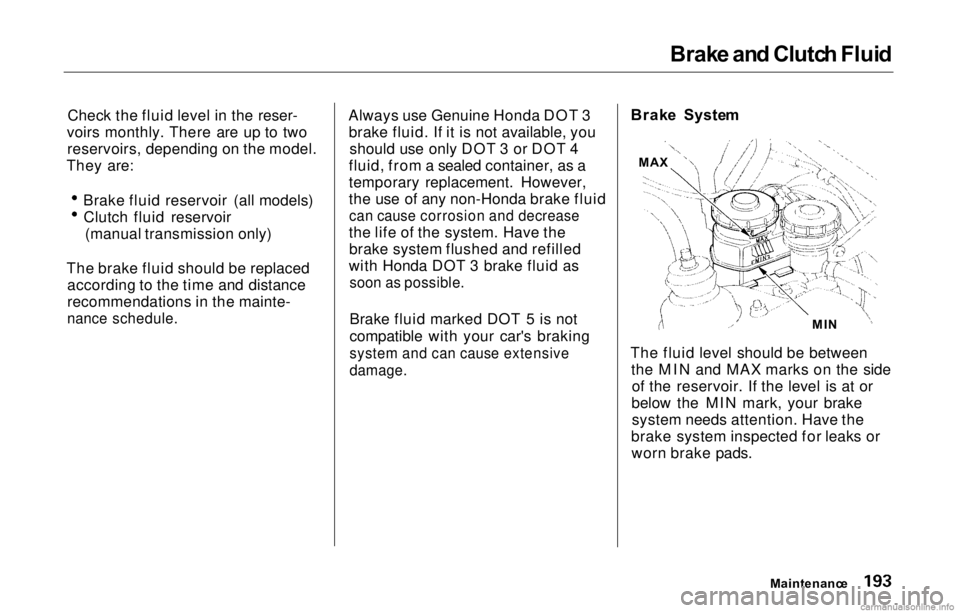
Brak
e an d Clutc h Flui d
Check the fluid level in the reser-
voirs monthly. There are up to two reservoirs, depending on the model.
They are: Brake fluid reservoir (all models)
Clutch fluid reservoir (manual transmission only)
The brake fluid should be replaced according to the time and distance
recommendations in the mainte-
nance schedule.
Always use Genuine Honda DOT 3
brake fluid. If it is not available, you should use only DOT 3 or DOT 4
fluid, from a sealed container, as a
temporary replacement. However,
the use of any non-Honda brake fluid
can cause corrosion and decrease
the life of the system. Have the brake system flushed and refilled
with Honda DOT 3 brake fluid as
soon as possible.
Brake fluid marked DOT 5 is not
compatible with your car's braking
system and can cause extensive
damage.
Brak
e Syste m
The fluid level should be between the MIN and MAX marks on the sideof the reservoir. If the level is at or
below the MIN mark, your brake system needs attention. Have the
brake system inspected for leaks or worn brake pads.
Maintenance
MI
N
MA
X
Page 197 of 293

Brak
e an d Clutc h Fluid , Powe r Steerin g
Clutc h Syste m
The fluid should be between the MIN and MAX marks on the side of
the reservoir. If it is not, add brake
fluid to bring it up to that level. Use
the same fluid specified for the
brake system.
Low fluid level can indicate a leak in
the clutch system. Have this system
inspected as soon as possible.
Powe
r Steerin g
Check the level when the engine is
cold. Look at the side of the
reservoir. The fluid should be
between the UPPER LEVEL and
LOWER LEVEL. If it is below the
LOWER LEVEL, add power steering
fluid to the UPPER LEVEL. Always use Genuine Honda Power
Steering Fluid. If it is not available,
you may use another power steering
fluid as an emergency replacement. However, continued use can cause
increased wear and poor steering in
cold weather. Have the powersteering system flushed and refilled
with Honda PSF as soon as possible.
A low power steering fluid level can indicate a leak in the system. Check
the fluid level frequently and have
the system inspected as soon as
possible.
Maintenanc e
Turning the steering wheel to full left
or right lock and holding it there can
damage the power steering pump.
MA
X
MI N UPPE
R LEVE L
LOWE R
LEVE L
NOTICE
Page 198 of 293
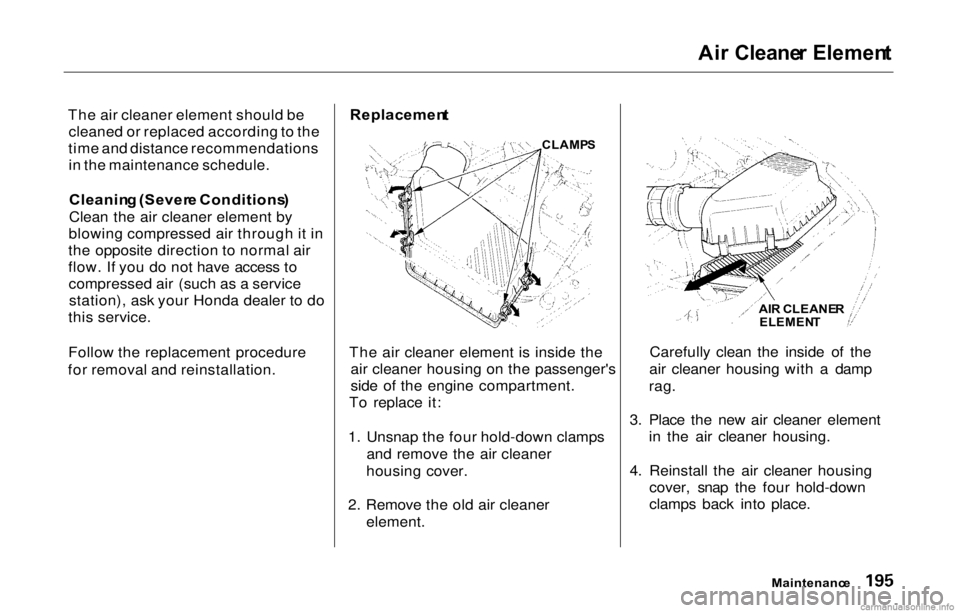
Ai
r Cleane r Elemen t
The air cleaner element should be cleaned or replaced according to the
time and distance recommendations in the maintenance schedule.
Cleanin g (Sever e Conditions )
Clean the air cleaner element by
blowing compressed air through it in
the opposite direction to normal air
flow. If you do not have access to compressed air (such as a servicestation), ask your Honda dealer to do
this service.
Follow the replacement procedure
for removal and reinstallation. Replacemen
t
The air cleaner element is inside the air cleaner housing on the passenger's
side of the engine compartment.
To replace it:
1. Unsnap the four hold-down clamps and remove the air cleaner
housing cover.
2. Remove the old air cleaner element. Carefully clean the inside of the
air cleaner housing with a damp
rag.
3. Place the new air cleaner element in the air cleaner housing.
4. Reinstall the air cleaner housing cover, snap the four hold-down
clamps back into place.
Maintenance
CLAMP
S
AIR CLEANE R
ELEMEN T
Page 199 of 293
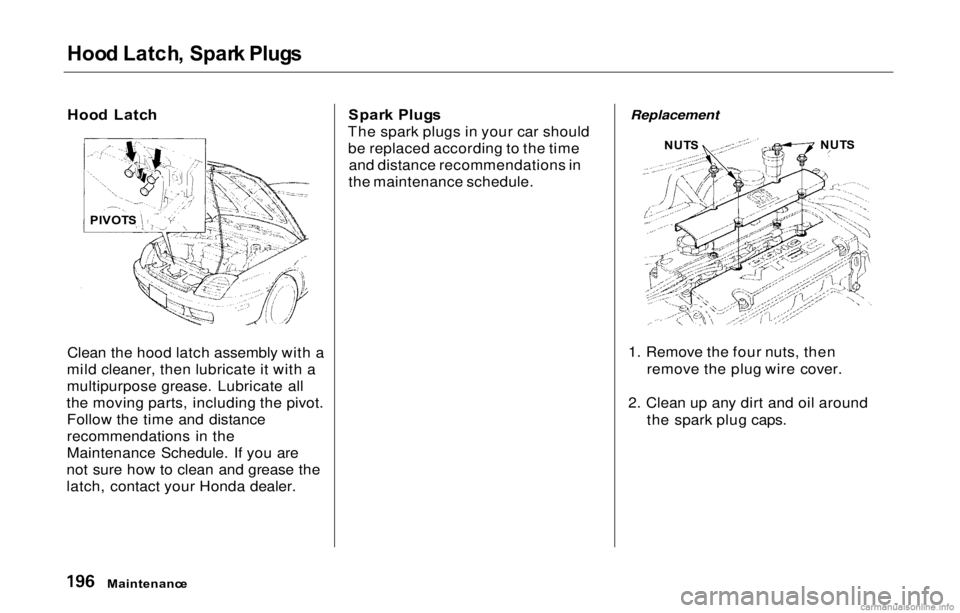
Hoo
d Latch , Spar k Plug s
Hoo d Latc h
Clean the hood latch assembly with a
mild cleaner, then lubricate it with a
multipurpose grease. Lubricate all
the moving parts, including the pivot. Follow the time and distance
recommendations in the
Maintenance Schedule. If you are
not sure how to clean and grease the
latch, contact your Honda dealer. Spar
k Plug s
The spark plugs in your car should be replaced according to the time and distance recommendations in
the maintenance schedule.
Replacement
1. Remove the four nuts, then remove the plug wire cover.
2. Clean up any dirt and oil around the spark plug caps.
Maintenanc e
PIVOT
S NUT
S NUT
S
Page 200 of 293
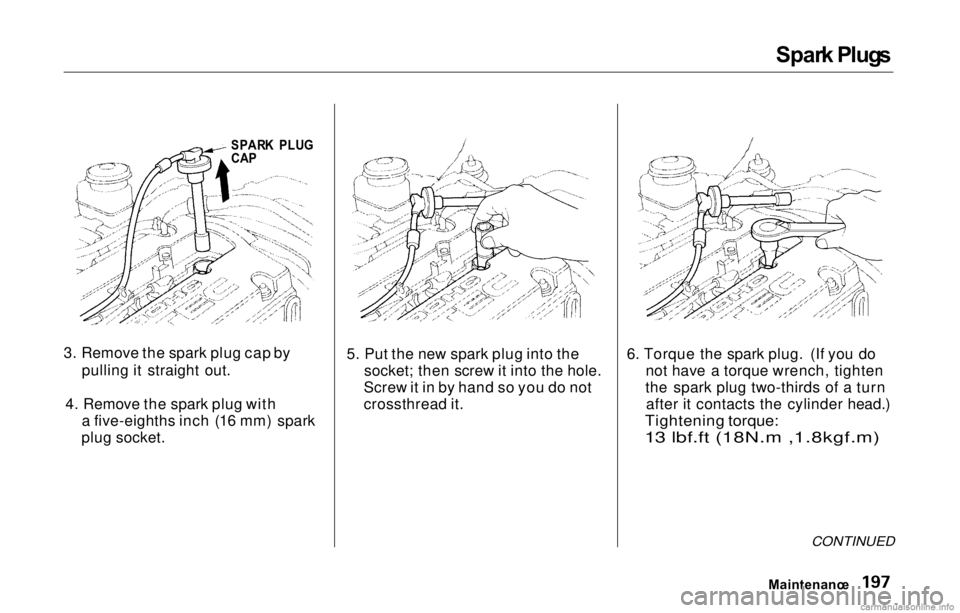
Spar
k Plug s
3. Remove the spark plug cap by pulling it straight out.
4. Remove the spark plug with a five-eighths inch (16 mm) spark
plug socket. 5. Put the new spark plug into the
socket; then screw it into the hole.
Screw it in by hand so you do not
crossthread it. 6. Torque the spark plug. (If you do
not have a torque wrench, tighten
the spark plug two-thirds of a turn after it contacts the cylinder head.)
Tightening torque:
13 lbf.ft (18N.m ,1.8kgf.m)
CONTINUED
Maintenanc e
SPAR
K PLU G
CA P